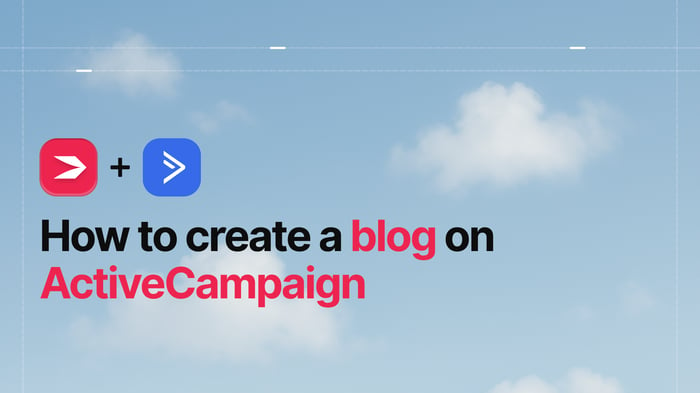An ActiveCampaign vs. HubSpot comparison is one that really makes sense. Although each emphasizes different aspects, both of these platforms operate in many overlapping areas, and they can be appealing to more-or-less similar audiences.
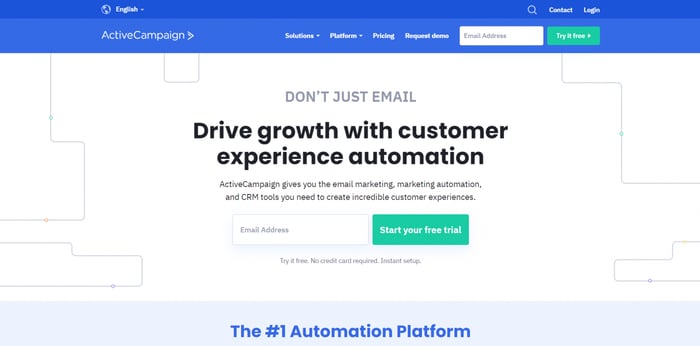
ActiveCampaign’s main forte is automation. With automation, as well as other types of tools, it helps you manage your audience efficiently, track your leads, and create a personalized user experience. Overall, it works to improve your relationship with your customers.
The most important part for your business is that all of this goes hand in hand with more conversions and business growth. It’s a win-win situation. You achieve your business goals by understanding your audience better and creating a high-quality user experience. At the same time, your audience receives the best possible service and the personalized approach they deserve.
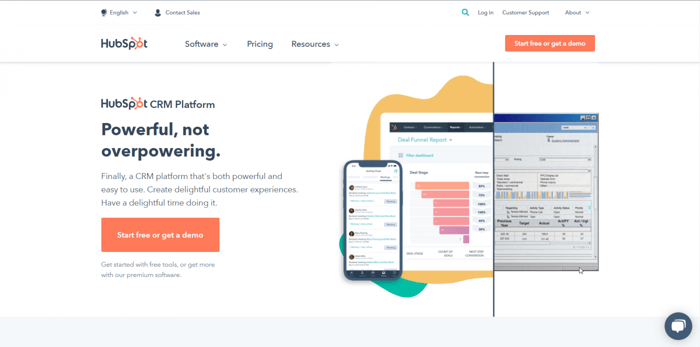
HubSpot excels in the CRM realm, but it doesn’t limit itself – it belongs to the category of all-in-one platforms. As such, HubSpot offers marketing, automation, sales, customer service, CMS, and other tools in one place.
Today, it’s one of the most popular and successful platforms of this type. Its success surely didn’t just drop from the sky. There must be a reason why so many businesses opt for HubSpot. Its versatility and good service undoubtedly play an important role, but we’ll get into all the details soon enough.
In the following few sections of this ActiveCampaign vs. HubSpot comparison, we’ll take a look at some of the most important and interesting facets of these platforms. Along the way, we hope that we’ll be able to help you see which one would work better for your business. So, let’s get started.
| An overview of both platforms: | ||
| ActiveCampaign | HubSpot | |
| Price and value |
|
|
| Key features |
|
|
| Customer service |
|
|
Table of Contents
Which Platform Is More Popular?
HubSpot was founded in 2006, while ActiveCampaign is a bit older, starting out in 2003. Despite being a couple of years younger in the market, based on market statistics like search trends, total monthly visits, visit duration, pages per visit, and bounce rates, HubSpot is more popular than ActiveCampaign.
For illustrative purposes, let’s look at the recent search trends and differences between the two platforms in this regard:

This is how things stand globally, but stats tell the same story about the U.S. and other big countries taken individually.
We can see the same considerable difference in popularity between HubSpot and ActiveCampaign in other areas we mentioned above as well:

Let’s look at some other stats to find out more about ActiveCampaign and HubSpot. In a study of over 800,000 companies published on Enlyft, HubSpot takes first place in the marketing automation category while ActiveCampaign comes in fifth:
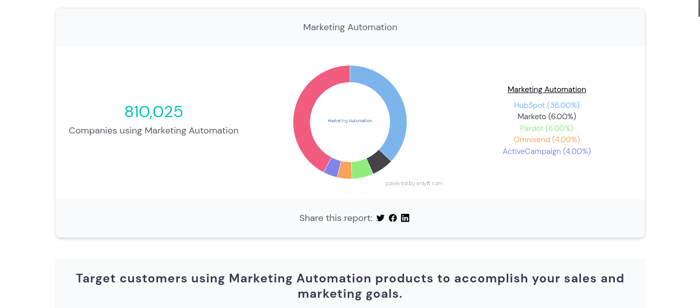
Analyzing the current marketing automation landscape, BuiltWith shows similar numbers. It examined over 5.4 million businesses that use marketing automation on the internet. Out of all platforms that offer marketing automation, again, HubSpot is the most popular, while ActiveCampaign holds fifth place:


That said, stats like these are helpful, but they don’t tell the full story. As you’ll see later, in contrast to what the stats here might imply, ActiveCampaign has made some big gains over HubSpot in certain areas.
More and more users are seeing the value that ActiveCampaign offers to businesses, and they want to get in on the perks of using this platform. Let’s go into these perks in more detail.
Price and Value
ActiveCampaign
Pricing Plans
ActiveCampaign offers four paid pricing plans. You can choose to pay for the plan of your choice either on a monthly or yearly basis. Before you make a final decision, you can test the platform for free for 14 days.
These are the current prices paid monthly for the four plans:

These are the current prices of the same plans when you buy a yearly subscription:
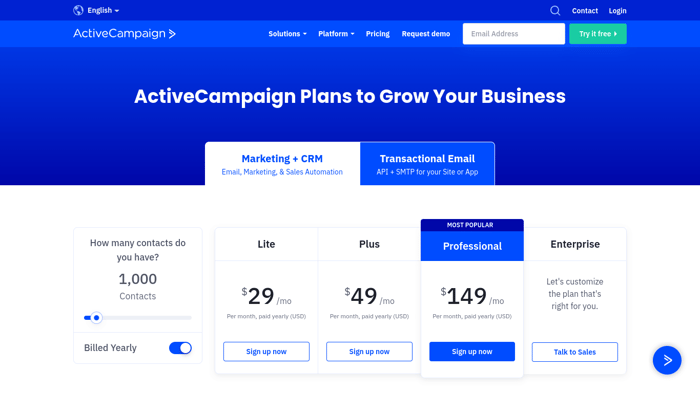
Clearly, a yearly subscription saves you money in the long run, but you have to pay a lot more at the outset, which can be a problem. The actual fees you pay when you choose a yearly subscription are the following:
- Lite: $348/year (annual discount) or $468/year if you pay monthly
- Plus: $588/year (annual discount) or $840/year if you pay monthly
- Professional: $1,788/year (annual discount) or $2,244/year if you pay monthly
- Enterprise: You’ll have to discuss with the sales team to confirm a custom pricing plan
Dynamic Pricing
One thing you need to keep in mind about ActiveCampaign’s pricing is that it varies depending on your number of contacts. The images above show the fees for businesses with up to 1,000 contacts. However, fees increase as the number of your contacts grows.
You can start with as few as 500 contacts or select 1,000, 2,500, 5,000, 10,000, or 25,000 contacts and above. Once you exceed 25,000 contacts – for most plans – you reach a point where you will have to customize your pricing plan.
Sometimes the price increase for the same plan can be huge or completely negligible. For instance, the Plus plan costs $70/month for 500 contacts, but when increased to 1,000 contacts, it still costs $70/month.
On the other hand, the Lite plan starts at $15/month for 500 contacts and increases to $39/month with 1,000 contacts.
Affordability and Cost-Effectiveness
One of the things that virtually everyone who has tried and used ActiveCampaign would agree on is that it’s a highly affordable customer experience automation platform. It’s much more affordable than its competition – we’re talking about companies like Convertkit, Mailchimp, Pardot, Keap, and, more importantly, HubSpot.
For a fairly cheap and highly customizable automation platform that offers a host of high-quality features, ActiveCampaign is extraordinarily cost-effective. It even includes some cutting-edge technology powered by machine learning innovations.
This is not just our opinion but the general consensus among users. Many even claim that they started with ActiveCampaign or migrated to this platform because it was much cheaper and more cost-effective than the alternatives.
It’s worth noting that we’ve already taken a deep dive into ActiveCampaign’s pricing system, so check it out if you want to gain a better understanding of the price breakdown.
HubSpot
Free Tools
One of the biggest advantages of the HubSpot pricing system is that it includes a package that provides you with a bunch of free tools:
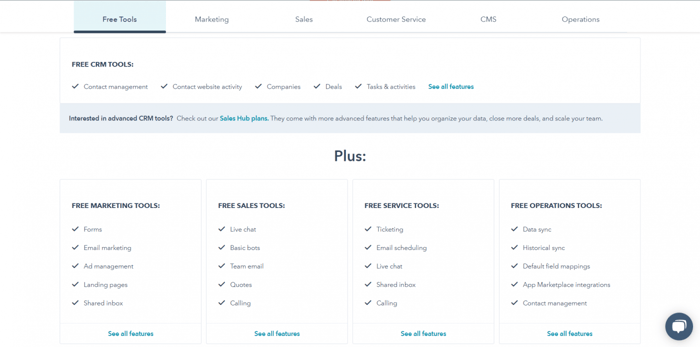
This may help you get started, but if you already have a flourishing business or need a serious set of tools, the free package just won’t do. For greater functionality, you’ll have to choose a paid plan.
Pricing Hubs
HubSpot has a somewhat complex pricing system. Instead of separate complete plans that we’re all kind of used to, it offers different service “hubs,” each of which includes three plans. The way the hubs are structured means that you may have to combine plans from different hubs to get the full set of tools you need.
We’ll look at the hubs in a moment. Before that, one caveat: here, we’ll only discuss the annual fees because they transparently show the price difference between a monthly and yearly subscription.
Marketing Hub
For individuals and small teams, the pricing is as follows:
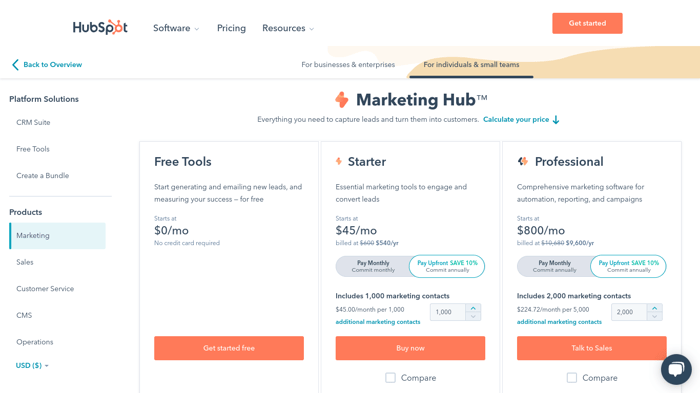
For small businesses and enterprise level companies, the prices are:
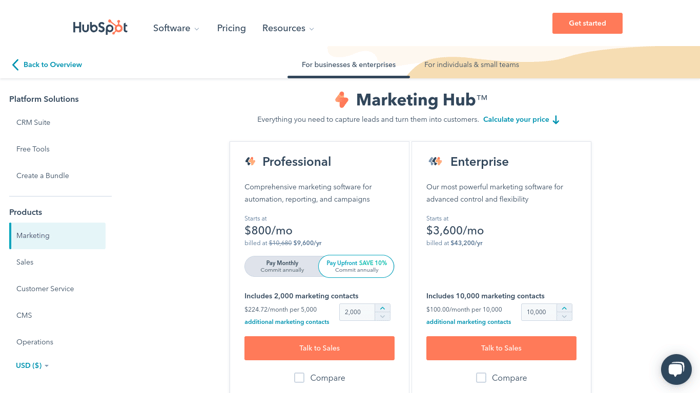
Taking into account the different pricing system structure, it’s almost difficult to compare ActiveCampaign with HubSpot. The Enterprise plan, within the marketing hub, is the most costly of all plans.
Sales Hub
The Sales Hub plans for individuals are:
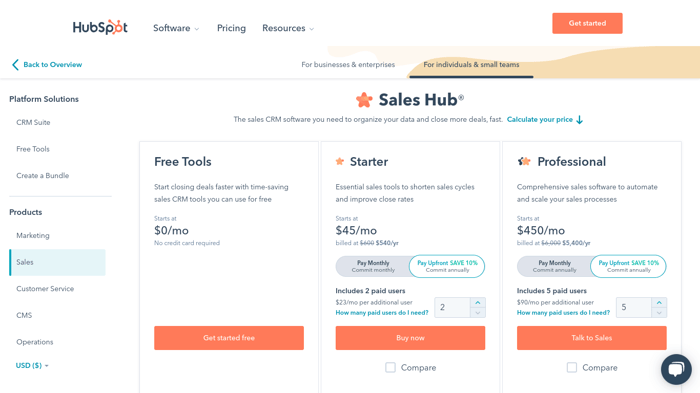
For larger businesses the prices are:
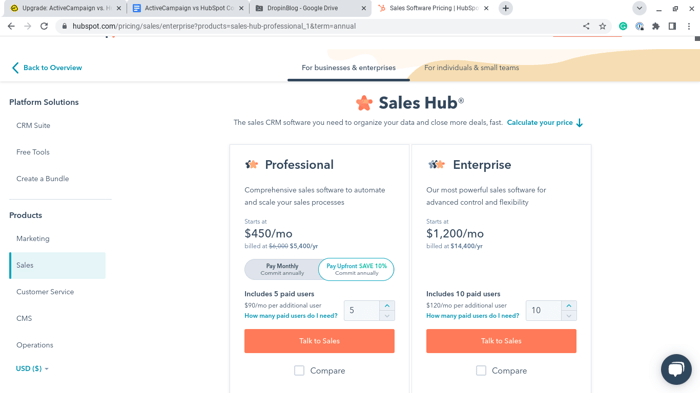
This is the rough price range with all of the remaining plans, but still not cheap.
Customer Service Hub
For individuals and small businesses the pricing plans are:
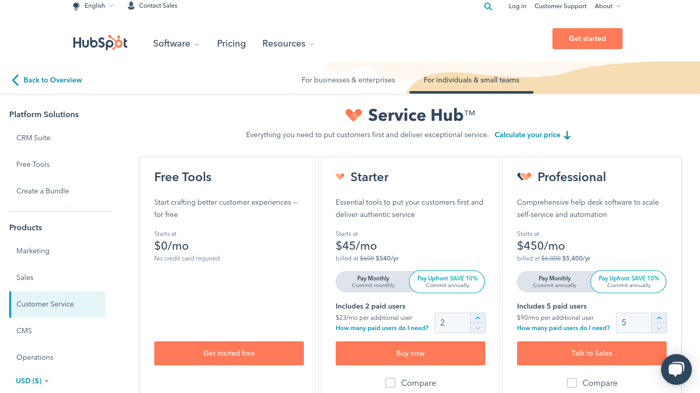
For larger businesses the plans best suited are:
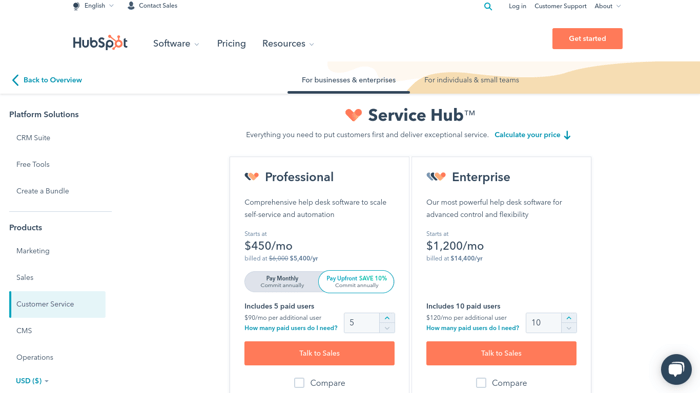
These prices are similar to those for the Sales Hub and the next CMS Hub.
CMS Hub
Within the CMS Hub there are three plans best suited to individuals:
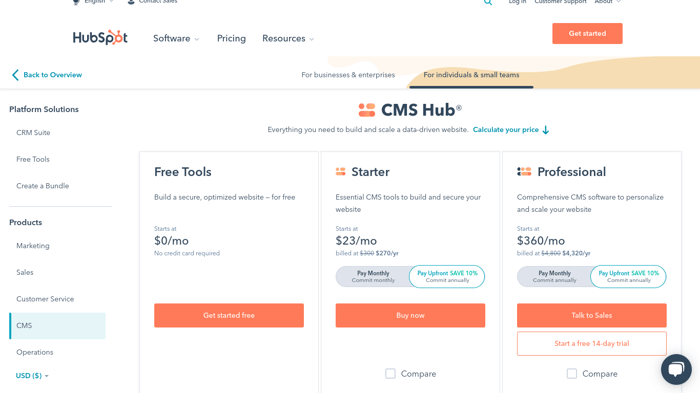
Two plans are designed for larger businesses:

One thing that you may have noticed about the pricing is that the enterprise plans within every hub include only annual billing. This does make sense, considering they cater to enterprise-level businesses who are sure about the longer-term commitment.
Operations Hub
This is the last hub:

For an enterprise level plan there are two more pricing options:
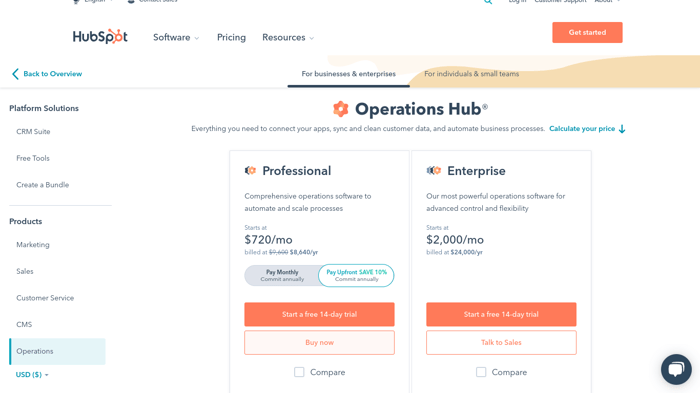
Dynamic Pricing
Similar to ActiveCampaign, HubSpot has dynamic pricing as well. For a larger number of contacts (Marketing Hub plans) and users (Sales Hub and Service Hub plans), HubSpot will charge you more. However, this is not all that you need to take into account when considering HubSpot.
Unlike ActiveCampaign, there’s more than one variable that determines how much you pay for HubSpot services. You can make changes to any of the following:
- Ads limit increase
- API limit increase
- Custom SSL add-on
- Reporting limit increase
- Dedicated IP add-on
- Transactional email add-on
- Lists limit increase
- Premium consulting
While optional, these are all things that you may need to factor in when you’re creating your HubSpot bundle.
Moreover, when calculating how much HubSpot will cost you, you also need to factor in plan combinations. If you want to have a variety of tools in one place, you’ll have to combine hubs. When you do this, you may end up paying a small fortune.
Affordability and Cost-Effectiveness
We’ve made it quite clear that HubSpot is hardly a cheap platform. For the majority of regular users and small businesses, it would not be viewed as an affordable option. The only scenario where you can say it’s affordable is if you’re just starting and the free package or the Starter plans can meet your needs. Once you need to scale up, the costs grow substantially, and not many businesses can afford prices that high.
There may be a rationale behind the steep prices, but that’s a topic that we’ll postpone. For now, we’ll focus on another question – is HubSpot cost-effective?
Overall, user opinions on this topic are mixed. However, it seems that more and more users who are aware of ActiveCampaign’s value for money tend to think that HubSpot is not a cost-effective solution. HubSpot has so many paywalls, and a significant number of its best features are available for a lot less money on ActiveCampaign.
On top of this, the highly confusing HubSpot pricing system makes ActiveCampaign far more appealing. All things considered, HubSpot pricing just won’t work for the majority of business owners. It’s likely going to be too expensive and simply not cost-effective.
Features
ActiveCampaign
As we implied earlier, ActiveCampaign provides unmatched service when it comes to automation, but it performs well in other areas as well. The following is a shortened list of some of the most interesting and invaluable tools you’ll find on this platform.
- Email split testing: Create up to five emails and test them simultaneously to see which subject line, content, image, call to action, and email works best in a given situation.
- Predictive sending powered by machine learning: Send an email at the best possible time when the probability for a contact to open the email and engage is the highest.
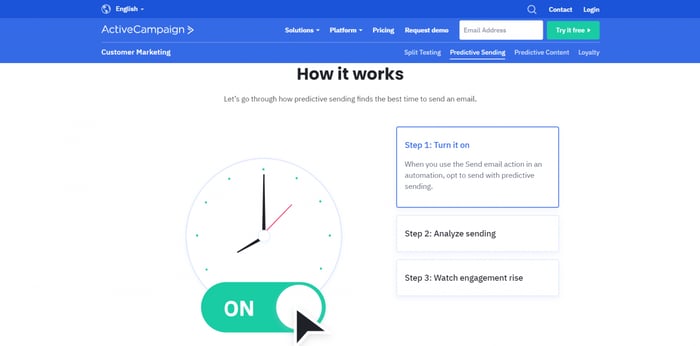
- Predictive content, also powered by machine learning: Send a personalized email with the most fitting content for a given contact.
- Win probability: Use machine learning to conclude which contacts have the most potential to close deals. You can also determine which cases you can apply automation with and when to use a personal approach.
- Sales pipelines: Create sales pipelines that help you track and lead your contacts through all the necessary stages until they convert into customers.
- CRM: It’s good to know that ActiveCampaign has got your back when it comes to CRM as well, but it’s fairly basic and thus best suited for small businesses.
- Loyalty program: Use automation to keep your customers engaged, offer discounts according to their preferences, and reward them for their loyalty.
- ActiveCampaign mobile app: Run your business on the go by managing and creating deals, tracking contacts, assigning tasks to your collaborators, and managing accounts.

- Automation templates: Use so-called “recipes,” essentially automation templates, to automate different aspects of your business more efficiently.
- Integrations: Search through over 850 apps in the ActiveCampaign Apps & Integrations store and find high-quality apps like DropInBlog to create a blog on ActiveCampaign, Shopify to do e-commerce more efficiently, Salesforce to take advantage of a powerful CRM, and Jotform to build custom forms.
If you’d like to read up on these tools and features in more detail, check out our thorough review of ActiveCampaign.
HubSpot
HubSpot, on the other hand, doesn’t perform that well in the automation realm, but when it comes to CRM and customer tracking, it’s one of the best in the business. These are some of the most interesting features that HubSpot offers:
- Free landing page builder: Build personalized, responsive, and professional landing pages that include CTAs in an easy-to-use visual drag-and-drop builder.
- Blog and content creation tools: Create appealing content that helps you inform your audience, build brand awareness, and generate more traffic as well as conversions.
- Email marketing: Build, customize, and give your marketing emails a personalized touch by using smart content (smart subject line, smart CTA, and smart text) that enables you to create emails tailored for your contacts.
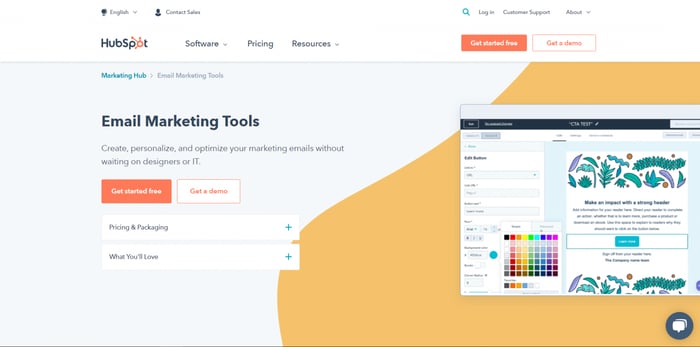
- Advanced CRM: As we already noted, this is the strongest side of HubSpot, so if a high-quality CRM is what you’re searching for, you can’t go wrong with HubSpot.
- Smart Send: This is the counterpart to ActiveCampaign’s predictive sending, although it’s not as powerful.
- A/B testing powered by machine learning: Automate split testing and gain more accurate insights about your audience thanks to the machine learning system used by HubSpot.
- Multiple deal pipelines: This is a feature that would work great for businesses that offer different products or simultaneously sell products and services, thus needing a way to cater to different types of customers.
- Contact deduplication: Another tool based on machine learning that compares large contact lists with a host of data entries and informs you if there are any duplicates, all in a matter of seconds.
- SEO keyword suggestions: A tool that gives you data-driven suggestions to help you optimize your content and rank higher in user searches.
- HubSpot App Marketplace: This is the place where you’ll find a ton of apps and integrations like Google Ads, Calendly, Stripe, Automate.io, and Integromat.
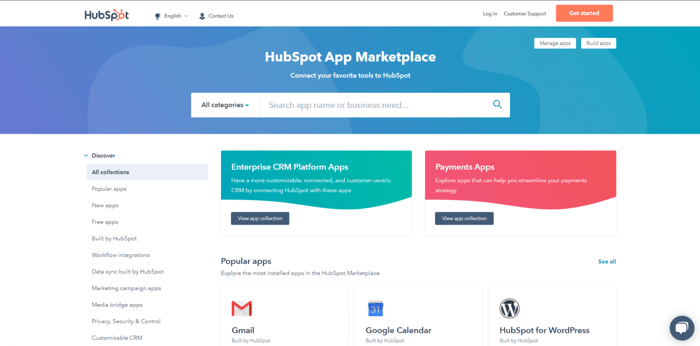
An All-In-One Platform: A Good or a Bad Solution?
As an all-in-one platform, HubSpot provides its customers with a lot of products and services of different types. While ActiveCampaign intentionally tries to dissociate itself from the category of all-in-one platforms, HubSpot promotes itself precisely as a one-stop solution. So, which one is better?
Of course, depending on your needs and ideas about what an ideal platform would look like, an all-in-one solution can be an advantage or a disadvantage. If you prefer the convenience of having access to as many tools as possible in one place, then HubSpot can be a great solution for you.
However, keep in mind that when a platform strives to do everything, usually it can’t perform as well as a platform specialized in a given area. For instance, an automation platform does automation better than the one that does both automation and content management. Likewise, a specialized blogging platform does blogging better than the one that does e-commerce, automation, and blogging.
Who Are ActiveCampaign and HubSpot For?
ActiveCampaign
ActiveCampaign fits well within the e-commerce context. If you run an e-commerce business and need a premium automation platform, ActiveCampaign is your friend.
It takes time to learn ActiveCampaign and understand how to get the most out of it, so it’s not going to be well suited to absolute beginners. However, small businesses and agencies run by experienced owners or people with some background knowledge can benefit tremendously from ActiveCampaign.
Speaking of which, small businesses and regular users seem to be one of the key categories that ActiveCampaign caters to, hence the lower prices and affordability.
HubSpot
Overall, like ActiveCampaign, HubSpot is not recommended for absolute beginners and inexperienced users. With the plethora of diverse features it offers, it can be overwhelming for newcomers.
Having access to so many tools can easily turn a blessing into a headache. Perhaps you don’t really need them if you’re unsure of their purpose or how to get the most out of them.
On the other hand, the free and Starter plans could be great value for startups.
In conclusion, HubSpot seems to be ideal for businesses that are looking for a robust CRM and have their other needs covered elsewhere. The steep prices of this platform suggest that it is better suited for large businesses, and that does seem to be the type of companies HubSpot caters to anyway.
FAQs
Does ActiveCampaign integrate with HubSpot?
It certainly is possible to integrate the two platforms. You can sync data from one to the other or both ways, depending on how you choose to use it.
Does ActiveCampaign allow you to start online stores?
Not directly with ActiveCampaign. ActiveCampaign is a marketing tools platform with all the automation functions you need and customer analysis potential, but it’s no site builder. You can build landing pages, but that’s the extent of it.
For a fully functional e-commerce store, you’ll need to build on something like Shopify and integrate ActiveCampaign.
Can I start a blog on ActiveCampaign and HubSpot?
HubSpot customers with access to the CMS hub will have the ability to create a blog. However, ActiveCampaign does not offer a native blogging tool. This means you’ll need to integrate a specialized blogging tool of your choice with your ActiveCampaign account – like DropinBlog.
Over and Out
In this ActiveCampaign vs. HubSpot comparison, we explored some interesting sides of these two platforms. Hopefully, we managed to show in what respect they are similar and where they differ.
So, which platform is a better fit for your business?


